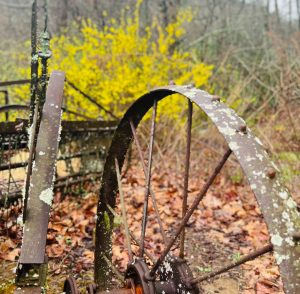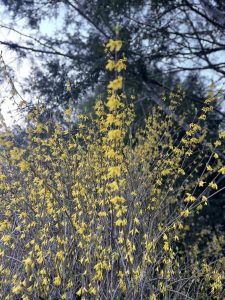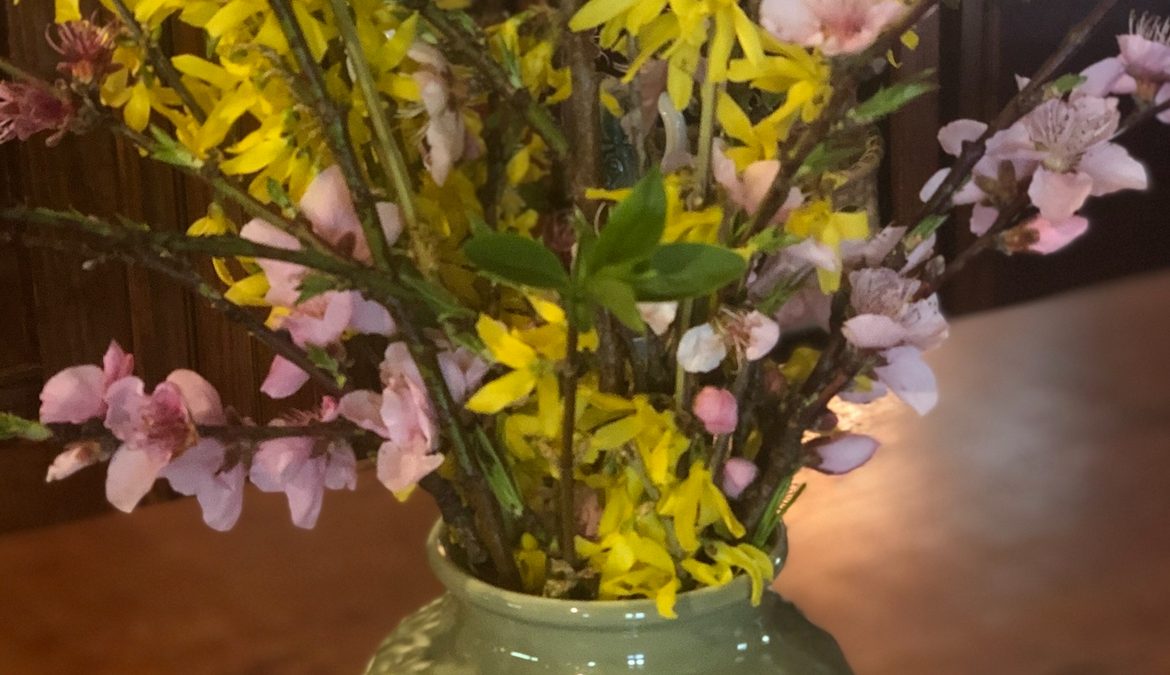Anticipating Forsythia
It grows along Selah Farm’s fences.
The yellow buds of forsythia serve to remind us—spring is coming in all its glory. It doesn’t wait until the threat of winter’s passed but, rather, blossoms with courage, then braves cold nights which will surely come.
And come they do, the frigid temps biting the buds, taking them too soon. This fact, however, doesn’t stop forsythia. In the two decades we’ve lived in White Oak, it’s faithfully debuted, bright as sunshine, in early March, though is often heavy with snow before April, weighed down but with determined delight.

Funny forsythia.
Come to find out, this plant—specifically, a deciduous shrub named for the Scottish botanist William Forsyth—is sometimes called the Easter Tree and, wonder of wonders, symbolizes anticipation.
And that just makes sense. After all, many folks are anticipating—watching for warmer, longer days. More sunshine. Less frost. More flowers. Less chance of snow.
Furthermore, some people fast throughout the Lenten season and are now anticipating its end—to eat dessert or drink soda, to participate in whatever it is they’ve denied themselves for forty days. Most of all, many are preparing their hearts for Good Friday, anticipating Resurrection Sunday.
Makes me wonder.
Did forsythia grow in Gethsemane’s Garden where Jesus prayed in earnest, anticipating what was coming and asking for his Father’s will (Luke 22:42)?
Did forsythia blossom near the Garden Tomb where women came with embalming spices? Followers of Jesus, they’d anticipated tending his body but discovered their Savior gone (Luke 24:1-2).
Did forsythia grow along the road to Emmaus, dotting the way with dancing yellow as three men journeyed, a not-yet-recognized Messiah sharing with the others an historical account? Beginning with Moses, he’d reminded them what scripture said concerning himself. Did the two travelers anticipate that, after this stranger joined them at the dinner table, their eyes would be open to see… Jesus (Luke 24:31)?
Did forsythia grow near the home where eleven frightened disciples gathered, waiting and wondering what would happen next? They likely anticipated persecution, with no one left to save them. But suddenly, Jesus appeared! Showing them nail-pierced hands and feet, did they anticipate he’d exclaim, like any good friend, and with the flesh of man, “Have you any food” (Luke 24:41b)?

And what about us? All these centuries later, do we anticipate the Easter Tree—that cross which held the One who took our sin and shame, then rose to new life that we might live with him?
With this faith, do we, like forsythia, cheerfully blossom where we’re planted, unafraid of the future—even death? Do we, like the Apostle Paul, proclaim, “….to live is Christ, to die is gain” (Phil. 1:21)?
I wonder.
Yes, let’s wonder at the wonderful man named Jesus—our Savior and best friend. Together, we anticipate all that’s been promised because of what he did so many years ago, looking forward to the day he’ll come again.
And may we never see forsythia quite the same, but instead, anticipate its coming with a renewed sense of…
Hope.
Father, thank You for all the reminders in the natural world of truths from Your Word. May we be filled with hope as we anticipate Jesus’s second coming, holding on to the promise that, until then, we never journey alone. Amen!
Tags In
Related Posts
4 Comments
Comments are closed.
Search
Subscribe to Blog via Email
Categories
- At Home (173)
- God's Word (180)
- His World (198)
- Uncategorized (5)





From this day on, I’ll picture forsythia’s shout whenever I read the Easter story, Maureen! A beautiful, hope-filled image. Thanks so much.
Oh, dear friend. Thank you! I heard the Lord whisper some time ago, “Write about forsythia.” (I know to some that may sound strange.) So I looked up its meaning, as I do with so many other plants I love. It said it meant “Anticipation.” I thought that was interesting… then, upon further investigation, learned in some places it’s called the Easter Tree. Can you even…? God is so so good! Bless you, friend! Living with eyes wide open WITH you!
Maureen, your post made me smile today because right as we were packed and ready to leave our home in NC for Norway, I ran to the storage room and brought up our forsythia wreath for the front door. I have always loved this sunny yellow sign of early spring. Even though we are not there to see it this year (and spring is still a month off here), I like to think of it hanging cheerfully on our door at home. I love that it symbolizes anticipation!
Oh, how wonderful! And maybe you’ll see some while in Norway too! I miss you! Anticipating your return with joy!